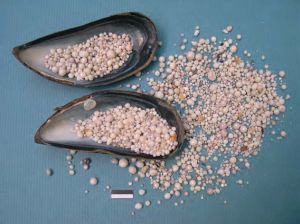| Currently running at the Smithsonian Institution Museum of Natural History, The Allure of Pearls is an Exhibition which will close on September 5th 2005. Some of the most fabulous and famous pearls in the world are on display including the Hope Pearl, the Pearl of Kuwait, the Pearl of Asia, Black Beauty and La Peregrina perhaps the most celebrated and historical pearl in the world. King Philip II of Spain gave it to Queen Mary I (Mary Tudor) and it has been owned by Spanish royalty, the Bonapartes of France and the British Marquis of Abercorn. In 1969 the actor Richard Burton gave this pear-shaped natural pearl to his wife, Elizabeth Taylor who had Cartier reset it with pearls, diamonds and rubies. Apart from oysters a number of other mollusc groups produce pearls including snails, conchs, abalones, clams and freshwater and marine mussels.
Not all pearls are desirable and those formed in edible molluscs such as marine mussels can be considered a nuisance as they are seldom appealing and have been the cause of many a cracked tooth. Species of the genus Mytilus are prone to develop large numbers of minute pearls in response to parasitism by a trematode that inhabits the intestine of certain duck species such as Eider and Scoter Duck. On shores where these ducks feed high incidences of pearl infestation render the mussels unsuitable for harvesting. The mussels act as an intermediate host for the trematode, and pearl formation is a reaction to the presence of immature stages of the trematode and their faeces in the tissues of the mussel. The mussel separates these foreign bodies and surrounds them with aragonitic shelly layers. Large mussel individuals may contain more than 100 pearls. Pearls: A Natural History, 2001. Landman, N.H., Mikkelsen, P.M., Bieler, R. & Bronson, B. Harry N Abrams Inc., New York, documents the human obsession with pearls. Legends (see page 13. Figure 17) Mytilus and Pearls Shell of Mytilus edulis with a blister pearl in situ, and a scatter of pearls obtained from a sample of mussels collected in the Firth of Clyde as part of a study into Mytilus pearl formation. Scale 1cm. |
Fig 1. Mytilus pearls. |
Pearls of Wisdom
Issue
8
Page
14

